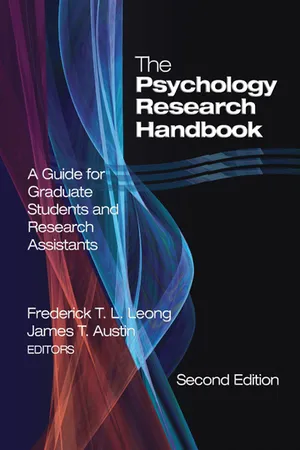Psychology
Self Report
A self-report in psychology refers to a method of gathering data where individuals provide information about their own thoughts, feelings, or behaviors. This can be done through questionnaires, interviews, or surveys. Self-reports are commonly used to assess personality traits, attitudes, and mental health symptoms, and they rely on the individual's self-awareness and ability to accurately report their experiences.
Written by Perlego with AI-assistance
Related key terms
1 of 5
4 Key excerpts on "Self Report"
- eBook - PDF
- John Hunsley, Catherine M. Lee(Authors)
- 2017(Publication Date)
- Wiley(Publisher)
Over the past century, psychologists have constructed literally thousands of measures of individual differences. Many of these mea- sures are designed to assess personality traits, which psychologists define as consistencies in behaviour, emotions, and attitudes that are evident across situations and across time. Personality theorists and researchers work to examine the influences of genetics and life experi- ences on the development of traits (Mischel, 2004) and how traits are expressed in everyday life (Hampson, 2012). Clinical psychologists are active in both researching personality traits and in assessing person- ality traits for clinical purposes. As you may know from taking a Assessment: Self-Report and Projective Measures Introduction The Person-Situation Debate Self-Presentation Biases Developing Culturally Appropriate Measures The Clinical Utility of Self-Report and Projective Measures Self-Report Personality Measures MMPI-2 and MMPI-A Other Clinical Measures of Personality Functioning Self-Report Checklists of Behaviours and Symptoms Achenbach System of Empirically Based Assessment SCL-90-R Outcome Questionnaire 45 Beck Depression Inventory-II Children’s Depression Inventory 2 Projective Measures of Personality Rorschach Inkblot Test Summary and Conclusions 170 CHAPTER 8 Assessment: Self-Report and Projective Measures personality theory course, personality measures vary in the scope of the constructs they are designed to assess. Some are intended to measure very broad constructs such as extraver- sion or neuroticism; others focus on highly specific constructs such as perfectionism or moti- vation for academic tasks. Most personality measures are based on self-report data and are often called objective personality tests because they can be scored objectively (i.e., the same scoring system is always used). - eBook - PDF
Introduction to Clinical Psychology
An Evidence-Based Approach
- John Hunsley, Catherine M. Lee(Authors)
- 2014(Publication Date)
- Wiley(Publisher)
Over the past century, psychologists have constructed literally thousands of measures of individual differences. Introduction The Person-Situation Debate Self-Presentation Biases Developing Culturally Appropriate Measures The Clinical Utility of Self-Report and Projective Measures Self-Report Personality Measures MMPI-2 and MMPI-A Other Clinical Measures of Personality Functioning Self-Report Measures of Normal Personality Functioning Self-Report Checklists of Behaviors and Symptoms Achenbach System of Empirically Based Assessment SCL-90-R Outcome Questionnaire 45 Beck Depression Inventory-II Children’s Depression Inventory 2 Projective Measures of Personality Rorschach Inkblot Test Thematic Apperception Test Summary and Conclusions Many of these measures are designed to assess personality traits, which psychologists define as consistencies in behavior, emotions, and attitudes that are evident across situations and across time. Personality theorists and researchers work to examine the influences of genetics and life experiences on the development of traits (Mischel, 2004) and how traits are expressed in everyday life (Hampson, 2012). Clinical psychologists are active in both researching personality traits and assessing personality traits for clinical purposes. As you may know from taking a personality theory course, personality measures vary in the scope of the constructs they are designed to assess. Some are intended to measure very broad constructs such as extraversion or neuroticism; others focus on highly specific constructs, such as perfectionism or motivation for academic tasks. Most personality measures are based on self-report data and are often called objective personality tests because they can be scored objectively (i.e., the same scoring system is always used). Other self-report measures are less complex than personality tests and are derived from descriptive characteristics of an experience or an event rather than from personality theories. - eBook - ePub
The Science of Self-report
Implications for Research and Practice
- Arthur A. Stone, Christine A. Bachrach, Jared B. Jobe, Howard S. Kurtzman, Virginia S. Cain, Arthur A. Stone, Christine A. Bachrach, Jared B. Jobe, Howard S. Kurtzman, Virginia S. Cain(Authors)
- 1999(Publication Date)
- Psychology Press(Publisher)
PART VISELF-REPORTING OF HEALTH BEHAVIORS AND PSYCHIATRIC SYMPTOMS
Howard S.Kurtzman National Institute of Mental HealthSelf-reports are a crucial—often the only—source of information about psychiatric symptoms and health behaviors. But until recently, the validity and reliability of self-reports in these domains have been inadequate. As the authors in this section show, improved methods for eliciting self-reports are now being developed that take into account the processes by which subjects understand and respond to self-report requests.Kessler, Wittchen, Abelson, and Zhao aim to improve the design of structured interviews for detecting psychiatric disorders in large community samples. Their recommendations address four determinants of subjects’ Self Reports: (a) Question comprehension: Questions should be phrased carefully to minimize vagueness and complexity and to clarify relations with preceding questions; (b) Task comprehension: It should be made clear to subjects whether, for example, a question is calling for an effortful search of memory or is only requesting easily accessible information; (c) Motivation: Subjects should be informed of the rationale for the interview, asked for an overt commitment to cooperate, and given verbal reinforcement throughout the interview; and (d) Ability to answer accurately: Questions should be structured in ways that encourage retrieval of specific autobio-graphical information rather than potentially biased inference or estimation about life events; also, more difficult memory searches should be placed at the beginning of the interview, before subjects’ energy wanes. As the authors describe, implementation of these recommendations in the U.S. National Comorbidity Survey appears to have yielded more effective detection of mental disorders.Rand focuses on self-reports of adherence to drug and other therapeutic regimens. She points out that self-reports have many potential advantages, such as providing detailed information about a patient’s pattern of adherence and the personal and situational factors that determine that pattern. But the accuracy of self-reports can be compromised by such factors as memory distortions and motives to provide socially desirable responses. Rand calls for systematic research to develop improved self-report instruments for assessing adherence in adults and children; these instruments would include items about the patient’s beliefs and attitudes concerning adherence and about specific barriers to adherence. She also points to research on physicians’ communication skills that suggests that direct, specific, but nonjudgmental questioning can increase the accuracy of self-reports in clinical settings. - No longer available |Learn more
The Psychology Research Handbook
A Guide for Graduate Students and Research Assistants
- Frederick T. L. Leong, James T. Austin(Authors)
- 2005(Publication Date)
- SAGE Publications, Inc(Publisher)
Participants may feel embarrassed or concerned about who might have access to their personal information or whether it can be traced back to them. With increased assurance of anonymity, however, it may be possible to increase the number of answered questions related to unpleasant sub-jects (Loewenthal, 2001). Researchers’ inability to understand the context in which the participants are reporting can represent another unfortunate limitation of self-report psychological instruments (Laing, 1988). For instance, when researchers assess participants’ feelings of depression through self-report instruments, some respondents, who may recently have experienced the death of a loved one, might respond affirmatively to items on these instruments, as compared with other respondents who might not have experi-enced similar life circumstances. Thus, partici-pants’ life circumstances often are not taken into account when interpreting the results of some self-report psychological tests, which might affect the conclusions that some researchers make about data they obtain from respondents. T ECHNOLOGY AND R ESEARCH In many ways, today’s investigators are fortu-nate because of numerous advances in technol-ogy that have occurred over the past 30 years. In particular, computers have contributed immensely to the ease of conducting sound psychological research (see Vaux & Briggs in Chapter 13 for more information). Computers can serve as vital tools to help investigators achieve their research goals and objectives from Selecting Psychological Measures • 111 the preliminary to the final phases of their research studies. Collecting Primary Information In the initial stages of research, collecting background information about the constructs of interest and finding ideal measures to assess these constructs has never been easier than with the use of computers. Before the Internet was widely accessible, individuals primarily used library card catalogues to locate specific references.
Index pages curate the most relevant extracts from our library of academic textbooks. They’ve been created using an in-house natural language model (NLM), each adding context and meaning to key research topics.



